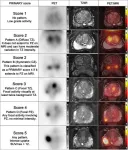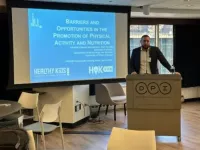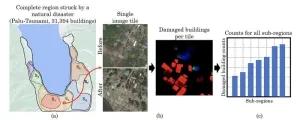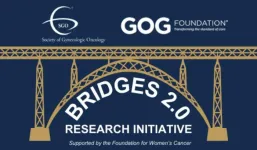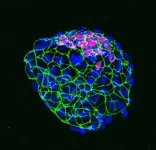(Press-News.org) We depend on our cells being able to divide and multiply, whether it’s to replace sunburnt skin or replenish our blood supply and recover from injury. Chromosomes, which carry all of our genetic instructions, must be copied in a complete way during cell division. Telomeres, which cap the ends of chromosomes, play a critical role in this cell-renewal process—with a direct bearing on health and disease.
The enzyme telomerase plays a key role in maintaining the length of telomeres as chromosomes replicate during cell division. UC Santa Cruz professor Carol Greider has been studying telomeres and telomerase for over 30 years. The impact of the discoveries she has made over that time are why she, along with two colleagues, won the Nobel Prize in Physiology or Medicine in 2009.
So, the findings of Greider’s latest study on telomeres shouldn’t have surprised her. And yet, they did.
Published online today in Science, a new study finds that telomere lengths follow a different pattern than has thus far been understood. Instead of telomere lengths falling under one general range of shortest to longest across all chromosomes, this study finds that different chromosomes have separate end-specific telomere-length distributions.
According to Greider, this discovery means we don’t fully understand the molecular process that regulates telomere lengths. And that’s important because of how telomere lengths affect human health: “When telomeres get to be too short, you have age-related degenerative diseases like pulmonary fibrosis, bone-marrow failure, and immunosuppression,” Greider said. “On the other hand, if telomeres are too long, it predisposes you to certain types of cancer.”
Kayarash Karimian, the lead author on the paper, is a former Ph.D. student in Greider’s lab at the Johns Hopkins University School of Medicine. Other co-authors of this study include researchers at the Dana-Farber Cancer Institute, Harvard Medical School, and University of Pittsburgh. Greider, a distinguished professor of molecular, cell, and developmental biology at UC Santa Cruz, and a University Professor at Johns Hopkins, was the senior author on the paper and led the work.
Why length matters
Without telomerase, telomeres would get shorter and shorter as a cell divides over and over again. Over the past 30 years, research by Greider and others have confirmed that short telomeres lead to degenerative disease—as well as shown that telomere lengths fall within a certain range.
But this paper challenges scientific consensus by showing that a singular telomere-length range is too broad. Measuring the telomeres of 147 people for this study, the researchers found in one individual that the average telomere length across all chromosomes was 4,300 bases of DNA. Then when they isolated specific chromosomes, they found most telomere lengths differed significantly from this average. In one case, lengths differed as much as 6,000 bases, which Greider describes as “jaw dropping.”
Further, they found across all 147 individuals the same telomeres were most often the shortest or longest, implying telomeres on specific chromosome ends may be the first to trigger stem-cell failure.
Innovating on nanopore sequencing
To make such precise measurements at the molecular level, Greider’s team used a technique invented at UC Santa Cruz called “nanopore sequencing,” a revolutionary method for reading DNA and RNA that has had an immense impact on genomics research since its 2014 debut on the market as the commercial product MinION.
Nanopore technology has enabled some of the most significant advances in the genomics field, such as the completion of a gapless human genome, and sequencing of COVID-19 genomes—making it crucial in the fight to end the pandemic. UC Santa Cruz licensed the concept for nanopore-sequencing technology to the UK-based company Oxford Nanopore Technologies, which made MinION, the first hand-held DNA sequencer.
Notably, in the eyes of nanopore sequencing’s inventors, Greider’s study proves that the technique’s ability to advance scientific research continues to unfold. Mark Akeson, emeritus professor of biomolecular engineering at UC Santa Cruz, notes that two preprint studies that corroborate the basic findings of Greider’s paper have also been posted online.
“In my opinion, this is the most important nanopore-based paper focused on human biology since the MinION was introduced,” Akeson said. “It is easy to envision broad use of their telomere-length assay in the clinic.”
Akeson and David Deamer, also an emeritus professor of biomolecular engineering at the Baskin School of Engineering, were honored at the Library of Congress last year for inventing nanopore sequencing. Their colleague and friend Daniel Branton, a Havard biologist and co-inventor of the technology, was honored as well.
Implications for disease prevention
Such precise DNA reads allowed Greider’s team to pinpoint the sequences adjacent to telomeres and hypothesize that those areas are where telomerase is regulating length. And if that’s true, Greider said those regions, and the proteins that bind there, could serve as potential targets for new drugs for preventing disease.
In addition, their process of “telomere profiling” via nanopore sequencing could serve as a model for the development of additional MinION-based assays for high-throughput drug screening.
“This accessible technique has widespread potential for use in research, diagnostics, and drug development,” Greider said. “This work indicates that there are yet undiscovered mechanisms for telomere length regulation; probing these mechanisms will inform new approaches to cancer and certain degenerative diseases.”
The study, “Human telomere length is chromosome end-specific and conserved across individuals,” was funded by grants from the National Institutes of Health (R35CA209974 to Greider and R01HL166265), the Johns Hopkins Bloomberg Distinguished Professorship, and the National Science Foundation Graduate Research Fellowship Program.
END
New study finds potential targets at chromosome ends for degenerative disease prevention
2024-04-11
ELSE PRESS RELEASES FROM THIS DATE:
Scientists discover first nitrogen-fixing organelle
2024-04-11
Modern biology textbooks assert that only bacteria can take nitrogen from the atmosphere and convert it into a form that is usable for life. Plants that fix nitrogen, such as legumes, do so by harboring symbiotic bacteria in root nodules. But a recent discovery upends that rule.
In two recent papers, an international team of scientists describe the first known nitrogen-fixing organelle within a eukaryotic cell. The organelle is the fourth example in history of primary endosymbiosis — the process by which a prokaryotic cell is engulfed by a eukaryotic cell and evolves beyond symbiosis into an organelle.
“It’s very rare that organelles ...
PET/MRI accurately classifies prostate cancer patients, offers potential to avoid unnecessary biopsies
2024-04-11
Reston, VA—PET/MRI can improve diagnostic accuracy for prostate cancer patients and help avoid unnecessary biopsies, according to new research published in the April issue of The Journal of Nuclear Medicine. By applying the PRIMARY scoring system to PET/MRI results, researchers found that more than 80 percent of unnecessary biopsies could be avoided at the expense of missing one in eight clinically significant prostate cancer cases.
The Prostate Imaging Reporting and Data System (PI-RADS) is a five-point ...
Researchers test new behavioral health interventions
2024-04-11
The concept of “One Health” – which emphasizes the relationship between human, animal, plant and environmental health – has been gaining ground in scientific discussions in recent years. Brazilian and North American researchers developing research using this approach presented their work on Tuesday (April 9th), in Chicago (United States), during FAPESP Week Illinois.
One of the panelists was Eduardo Esteban Bustamante, a professor at the University of Illinois in Chicago. He talked about behavioral interventions that have been tested to promote physical activity and healthy eating – practices that, according to the researcher, ...
New computer vision tool wins prize for social impact
2024-04-11
AMHERST, Mass. – A team of computer scientists at the University of Massachusetts Amherst working on two different problems—how to quickly detect damaged buildings in crisis zones and how to accurately estimate the size of bird flocks—recently announced an AI framework that can do both. The framework, called DISCount, blends the speed and massive data-crunching power of artificial intelligence with the reliability of human analysis to quickly deliver reliable estimates that can quickly pinpoint and count specific features from very large collections ...
The Society of Gynecologic Oncology (SGO) and The GOG Foundation, Inc. (GOG-F) launch BRIDGES 2.0 Research Initiative with support from the Foundation for Women’s Cancer (FWC).
2024-04-11
PRESS RELEASE
Chicago, IL and Philadelphia, PA, USA, April 11, 2024: The Society of Gynecologic Oncology (SGO) and The GOG Foundation, Inc. (GOG-F) Launch BRIDGES 2.0 Research Initiative with support from the Foundation for Women’s Cancer (FWC). After a successful inaugural year, the SGO and the GOG-F join forces to collaborate, and proudly announce the launch of an expanded two-year clinical trial education program supported by the FWC. This important career and clinical trial development initiative aims to cultivate the next generation of investigators in gynecologic oncology and will focus on clinical and translational research ...
Embryos in hungry mouse mums postpone development
2024-04-11
It’s challenging to sustain a pregnancy when food is short, or conditions are otherwise tough. That’s why many mammalian embryos can postpone their growth to get through periods of environmental stress and then re-enter development when conditions improve. This stalling of development is known as embryonic diapause, and understanding the mechanisms behind it might help improve infertility treatments, such as embryo freezing. Now, researchers at the Center for Excellence in Brain Science and Intelligence Technology, the Chinese Academy of Sciences in Shanghai, China, have discovered how nutrient depletion is sensed by embryos growing in hungry mouse mums to induce diapause. ...
Scripps Research study reveals new approach for combatting “resting” bacteria
2024-04-11
LA JOLLA, CA—Most disease-causing bacteria are known for their speed: In mere minutes, they can double their population, quickly making a person sick. But just as dangerous as this rapid growth can be a bacterium’s resting state, which helps the pathogen evade antibiotics and contributes to severe chronic infections in the lungs and blood, within wounds, and on the surfaces of medical devices.
Now, Scripps Research scientists have discovered how long chains of molecules called polyphosphates (polyP) are needed for bacteria to slow down movements within cells and let them enter this resting ...
UT Health San Antonio appoints Anthony Francis as associate vice president for innovation and development
2024-04-11
SAN ANTONIO, April 10, 2024 – The University of Texas Health Science Center at San Antonio (UT Health San Antonio) has appointed Anthony Francis, a renowned leader in translating research to market opportunity, as associate vice president for innovation and development in the Office of the Vice President for Research.
He joins the institution from the University of California San Francisco, where he was executive director of the Office of Technology Management and Advancement. Francis is credited with transforming ...
Study finds increased anxiety and PTSD among people who remained in Ukraine
2024-04-11
Researchers from the International Blast Injury Research Network at the University of Southampton conducted a survey to understand how the mental health of displaced Ukrainians has been affected by the ongoing war. Their findings, published in PLOS Global Public Health, describe high levels of post-traumatic stress disorder (PTSD) and generalized anxiety among both refugees and people displaced within Ukraine.
Since the Russian invasion of Ukraine began in February 2022, at least 13 million people have been displaced from their homes. Both exposure ...
Image-based artificial intelligence spots parasitic worm infections in children's stool samples
2024-04-11
Image-based artificial intelligence spots parasitic worm infections in children's stool samples, particularly light intensity infections that may be missed by manual microscopy.
#####
Article URL: http://journals.plos.org/plosntds/article?id=10.1371/journal.pntd.0012041
Article Title: Diagnosis of soil-transmitted helminth infections with digital mobile microscopy and artificial intelligence in a resource-limited setting
Author Countries: Finland, Kenya, Sweden
Funding: This research was financially supported by The Erling-Persson Foundation (grant number 2021 0110) JL, Vetenskapsrådet (grant number 2021-04811) JL, Finska Läkaresällskapet ...
